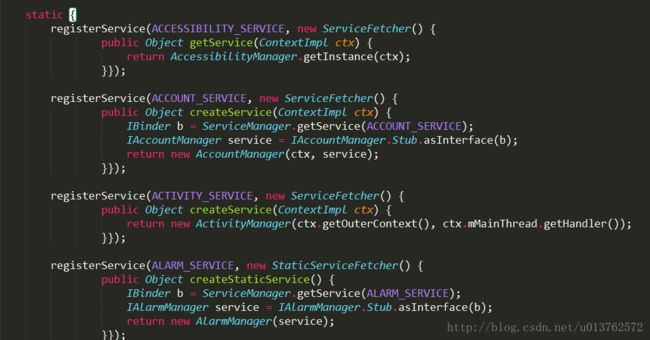读书笔记(二)---看看LayoutInflater的源码
饱汉模式
在读完单例模式的介绍之后,发现android的很多系统级的服务都是以单例模式存在的,我们很多时候都是以这种方式进行调用的:
LayoutInflater inflater = (LayoutInflater) getSystemService(LAYOUT_INFLATER_SERVICE);这里的getSystemService我们可以看源码:
@Override
public Object getSystemService(String name) {
ServiceFetcher fetcher = SYSTEM_SERVICE_MAP.get(name);
return fetcher == null ? null : fetcher.getService(this);
}源码来自andorid.app.ContextImpl中,因为Context是一个抽象类,而ContextImpl就是它的实现类,而SYSTEM_SERVICE_MAP是一个静态的Map对象:
当ContextImpl类字节码加载时,android系统就开始注册各种服务了:

如果需要使用各种服务时,我只需要从静态的MAP中获取就行了:

显然这是单例模式中非常经典的饱汉模式了。
LayoutInflater
再次看ContextImpl中关于LayoutInflater注册代码:

有个PolicyManager类,估计是个java类,使用everything 搜索一下源码,可以发现:
/**
* {@hide}
*/
public final class PolicyManager {
private static final String POLICY_IMPL_CLASS_NAME =
"com.android.internal.policy.impl.Policy";
private static final IPolicy sPolicy;
static {
// Pull in the actual implementation of the policy at run-time
try {
Class policyClass = Class.forName(POLICY_IMPL_CLASS_NAME);
sPolicy = (IPolicy)policyClass.newInstance();
} catch (ClassNotFoundException ex) {
throw new RuntimeException(
POLICY_IMPL_CLASS_NAME + " could not be loaded", ex);
} catch (InstantiationException ex) {
throw new RuntimeException(
POLICY_IMPL_CLASS_NAME + " could not be instantiated", ex);
} catch (IllegalAccessException ex) {
throw new RuntimeException(
POLICY_IMPL_CLASS_NAME + " could not be instantiated", ex);
}
}
// Cannot instantiate this class
private PolicyManager() {}
// The static methods to spawn new policy-specific objects
public static Window makeNewWindow(Context context) {
return sPolicy.makeNewWindow(context);
}
public static LayoutInflater makeNewLayoutInflater(Context context) {
return sPolicy.makeNewLayoutInflater(context);
}
public static WindowManagerPolicy makeNewWindowManager() {
return sPolicy.makeNewWindowManager();
}
public static FallbackEventHandler makeNewFallbackEventHandler(Context context) {
return sPolicy.makeNewFallbackEventHandler(context);
}
}很显然PolicyManager是一个代理类,真正实现其作用的是 通过反射的com.android.internal.policy.impl.Policy的Policy,找到该类:

看到这里,我们才发现以前一直用的LayoutInflater,原来是其子类PhoneLayoutInflater,好吧,我们去看看这个PhoneLayoutInflater是怎么写的:
public class PhoneLayoutInflater extends LayoutInflater {
private static final String[] sClassPrefixList = {
"android.widget.",
"android.webkit."
};
/**
* Instead of instantiating directly, you should retrieve an instance
* through {@link Context#getSystemService}
*
* @param context The Context in which in which to find resources and other
* application-specific things.
*
* @see Context#getSystemService
*/
public PhoneLayoutInflater(Context context) {
super(context);
}
protected PhoneLayoutInflater(LayoutInflater original, Context newContext) {
super(original, newContext);
}
/** Override onCreateView to instantiate names that correspond to the
widgets known to the Widget factory. If we don't find a match,
call through to our super class.
*/
@Override protected View onCreateView(String name, AttributeSet attrs) throws ClassNotFoundException {
for (String prefix : sClassPrefixList) {
try {
View view = createView(name, prefix, attrs);
if (view != null) {
return view;
}
} catch (ClassNotFoundException e) {
// In this case we want to let the base class take a crack
// at it.
}
}
return super.onCreateView(name, attrs);
}
public LayoutInflater cloneInContext(Context newContext) {
return new PhoneLayoutInflater(this, newContext);
}
}它只是重写了onCreateView方法,感觉也没干什么嘛,先等一下,再去看看我们很熟悉的LayoutInflater方法:

所有的方法最终都转化为了
public View inflate(XmlPullParser parser, @Nullable ViewGroup root, boolean attachToRoot) {这个方法中源码比较多,稍微理清一下思路再看:
//....代码省略
View result = root;
int type;
while ((type = parser.next()) != XmlPullParser.START_TAG &&
type != XmlPullParser.END_DOCUMENT) {
// Empty
}
final String name = parser.getName();
//解析merge标签下View视图
if (TAG_MERGE.equals(name)) {
if (root == null || !attachToRoot) {
throw new InflateException("总结一下解析的过程:
A.解析XML的根标签,也就是第一个标签;
B.如果是merge标签,那么会调用rInflate方法,rInflate就将merge标签下的所有子View直接添加到根标签中;
C.如果是一般标签,直接调用createViewFromTag方法进行解析;
D.递归所有子视图,并将其添加到其parentView中;
E.返回解析到的根视图.
先不看merge,先看我们一般情况下的createViewFromTag方法,看看它是怎么解析的:
View view;
//代码省略.....
if (view == null) {
final Object lastContext = mConstructorArgs[0];
mConstructorArgs[0] = context;
try {
if (-1 == name.indexOf('.')) {
view = onCreateView(parent, name, attrs);
} else {
view = createView(name, null, attrs);
}
} finally {
mConstructorArgs[0] = lastContext;
}
}
return view;
}其它无关或者说不重要的代码都去掉了,主要是看一下比较重要的代码,看到主要判断是name.indexOf(“.”)方法,当然我们一般在XML布局文件中写View视图时,如果是TextView,Button,WebView等等android系统内置的标签,都是可以不写前缀的,就像一下:
<TextView
android:layout_width="wrap_content"
android:layout_height="wrap_content"
android:text="Hello World!"/>而对于自定义的View,都需要加上自定义View的全路径,也就是前缀,如下:
<com.micro.view.MyTextView
android:layout_width="wrap_content"
android:layout_height="wrap_content"
android:text="Hello World!"/>从这里我们就可以知道其中的原因了。
而onCreateView方法,作为LayoutInflater的具体实现,我们的PhoneLayoutInflater已经重写了该方法,还是上面的代码,我们再拿过来用一下,PhoneLayoutInflater中的onCreateView方法:
private static final String[] sClassPrefixList = {
"android.widget.",
"android.webkit."
};
@Override
protected View onCreateView(String name, AttributeSet attrs) throws ClassNotFoundException {
for (String prefix : sClassPrefixList) {
try {
View view = createView(name, prefix, attrs);
if (view != null) {
return view;
}
} catch (ClassNotFoundException e) {
// In this case we want to let the base class take a crack
// at it.
}
}
return super.onCreateView(name, attrs);
}好吧,我们发现这个onCreateView方法最终还是调用了createView,这是给我们自动加上了android.widget. 或者android.webkit前缀,这个我们可以确定的是,Google为了让开发者节省时间和精力,减少书写鸡肋代码,将这些前缀都给我们去掉了,那我们去看看这个createView方法吧:
public final View createView(String name, String prefix, AttributeSet attrs)
throws ClassNotFoundException, InflateException {
//这个是缓存构造器的容器
Constructor extends View> constructor = sConstructorMap.get(name);
if (constructor != null && !verifyClassLoader(constructor)) {
constructor = null;
sConstructorMap.remove(name);
}
Classextends View> clazz = null;
//容器不存在时,首先使用反射将constructor搞出来,然后缓存起来
if (constructor == null) {
clazz = mContext.getClassLoader().loadClass(
prefix != null ? (prefix + name) : name).asSubclass(View.class);
constructor = clazz.getConstructor(mConstructorSignature);
constructor.setAccessible(true);
sConstructorMap.put(name, constructor);
} else {
//其他的一些啥判断....
}
Object[] args = mConstructorArgs;
args[1] = attrs;
//此时调用constructor的newInstance创建对象,所以啊我们的构造函数很重要的啊
final View view = constructor.newInstance(args);
if (view instanceof ViewStub) {
// Use the same context when inflating ViewStub later.
final ViewStub viewStub = (ViewStub) view;
viewStub.setLayoutInflater(cloneInContext((Context) args[0]));
}
return view;
抛开其它判断的逻辑,可以看到createView还是很清晰简单的,先获取构造器缓存,没有则使用classLoader加载一个,然后使用newInstance方法获取我们需要的View对象。过程还是蛮简单的。
好了,那么现在就来看看解析子View中的方法吧,rInflateChildren方法最终调用的是:
final void rInflateChildren(XmlPullParser parser, View parent, AttributeSet attrs,
boolean finishInflate) throws XmlPullParserException, IOException {
rInflate(parser, parent, parent.getContext(), attrs, finishInflate);
}现在来看看这个rInflate方法:
void rInflate(XmlPullParser parser, View parent, Context context,
AttributeSet attrs, boolean finishInflate) throws XmlPullParserException, IOException {
//获取视图树的深度,深度优先遍历
final int depth = parser.getDepth();
int type;
while (((type = parser.next()) != XmlPullParser.END_TAG ||
parser.getDepth() > depth) && type != XmlPullParser.END_DOCUMENT) {
if (type != XmlPullParser.START_TAG) {
continue;
}
final String name = parser.getName();
//....其余代码.....
//解析子元素对象View
final View view = createViewFromTag(parent, name, context, attrs);
final ViewGroup viewGroup = (ViewGroup) parent;
//再次递归获取子元素
final ViewGroup.LayoutParams params = viewGroup.generateLayoutParams(attrs);
rInflateChildren(parser, view, attrs, true);
//添加子元素到ViewGroup中
viewGroup.addView(view, params);
}
if (finishInflate) {
parent.onFinishInflate();
}
}
rInflate通过深度优先遍历来构造视图树,每解析到一个View元素就会递归调用rInflate,直到这条路径下的最后一个元素,然后再回溯过来将每一个View元素添加到它们的parent中,通过rInfalte的解析之后,整棵视图树就构建完毕了,当onResume方法之后,视图就在在我们眼中了。
当然个人感受有一下几种:
1.感觉PhoneLayoutInflater是android的一个补丁,为什么这么说呢?我们可以看一下LayoutInflater的onCreateView方法:

我个人的感觉就是当初andorid设计,所有的View类是在到android.view.* 包下,后来在编码的时候,View类不在这个view包下了,然后就打了补丁,重写了onCreateView方法,使之可以重新访问android.widget.,或者android.webkit.下的View类了,不能不说,这个‘补丁’打得很有水平啊,绕了好几道弯啊。。。
2.XML解析基本上都忘记了,这个rInflate就是因为XML解析绕了很久。
好了,断断续续写完了,明天继续上班了啊。。。
